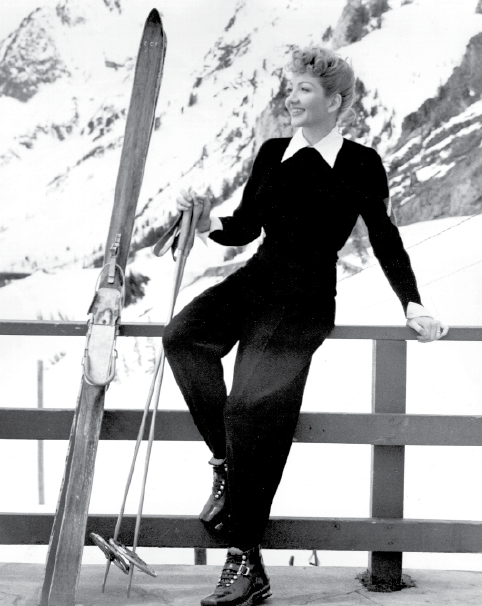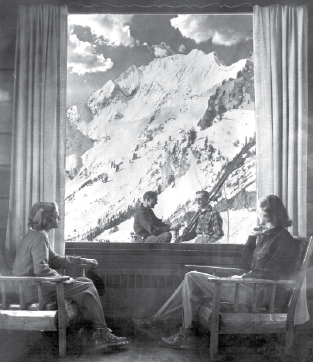With thousands of photos, clippings, film and manuscripts, this collection tells the ski story of the Intermountain West. By Mike Korologos
Pictured above: Dr. Greg Thompson, co-founder of the J. Willard Marriott Library Utah Ski Archives, and Molly Creer, moving image and sound archivist in Special Collections, display a few items from the library’s extensive ski archives.
 To the first-time visitor, the shipping and receiving dock at the main campus library at the University of Utah in Salt Lake City appears similar to one you’d see at a grocery or furniture warehouse—high overhead clearance, heavy-duty rubber bumper guards on the dock platform, oversized metal doors with wire security windows and several “no parking” signs.
To the first-time visitor, the shipping and receiving dock at the main campus library at the University of Utah in Salt Lake City appears similar to one you’d see at a grocery or furniture warehouse—high overhead clearance, heavy-duty rubber bumper guards on the dock platform, oversized metal doors with wire security windows and several “no parking” signs.
Pictured to the right: Hollywood leading lady Claudette Colbert strikes a publicity pose on the front porch of the Alta Lodge in the early 1940s. Photo credit Clyde Anderson / special collections / J. Willard Marriott Library / University of Utah
If you’re delivering boxes of old documents, news clippings, files, photos, videos, scrapbooks or collections for inclusion in the library’s Utah Ski Archives, the dock takes on an entirely different persona in that nanosecond when you notice the person about to receive your materials is wearing white gloves.
Yes, white gloves—to protect your materials (that “ski stuff” that’s been gathering dust for decades in the attic, garage or crawl space at home) from the body oils that fingerprints might place on them. What’s more, if you return to the library months or years later to look up an item in your donated materials, you too will be required to wear white gloves before you are allowed to handle any of that once-forgotten, almost-trashed “ski stuff.”
Such is the meticulous care that underscores the receiving, identifying, labeling, categorizing, cataloguing and filing of materials at the J. Willard Marriott
Library’s Special Collections, thus making them easily referenced by an international audience of students, scholars, researchers, historians, authors, reporters, photographers and others. It’s a ski historian’s nirvana, especially for researchers mining for nuggets of information regarding the history of skiing in the Intermountain Area (comprising Utah, Idaho and Wyoming).
Viewed in total, the collection includes several thousand photos, plus negatives, movie film, video cassettes, scrapbooks, news clippings, lift tickets, brochures, letters, interviews, posters, personal manuscripts, oral histories, books, and ski team and ski area files. (For an overview of the collection, see “Details” sidebar on page 13.) Dr. Gregory C. Thompson, assistant dean and director of Special Collections at the library, co-founded the ski archive in 1989 and has watched the collection grow exponentially ever since.
“Funding wasn’t a big deal when we got our first few collections,” Thompson recalls. “But we sure can’t say that now. While we’re thrilled to see the archives grow into such prominence, with that growth comes the continual task of raising funds.” While the library’s annual budget covers the collection’s basic costs—such as salaries for key employees—the staff also raises outside funds through events, foundations, and individual and corporate donors.
This additional revenue supports part-time student employees who help with organizing, scanning and developing the collection; and the costs of storage, preservation, acquisitions and the Website.
Among the early significant collections that Thompson describes came from Alta, Utah’s first lift-served ski area (1938). In 1989 the library’s development director, the late Sue Raemer, was a second-generation ski instructor at Alta, where she learned that the company was looking to significantly thin its vast files, some dating to its mining heyday of the 1870s.
That’s when Raemer and Thompson had an “ah-ha” moment: “Why not have Alta donate its unwanted documents to the University of Utah library’s Special Collections?” Raemer’s foresight and fortuitous dual employment were coupled with Thompson’s expertise in launching archives to give birth to a cocktail party for 200 local ski aficionados who heartily endorsed the Ski Archives idea.
Within a few years that cocktail party evolved into a ski season-launching extravaganza called The Utah Ski Archives Ski Affair. The event is the library’s most prominent outreach activity, raising $40,00 to $50,000 every fall (see sidebar). Another significant library outreach effort links the archive with the Alf Engen Ski Museum, in Park City, which serves as a repository for multi-dimensional collectibles—such as trophies or equipment—that the library does not store. (The museum is an ISHA partner, and Skiing History serves as its official publication.)
“The affiliation with the museum gives the library’s historical preservation efforts a very broad visual component that is popular with the public,” says Thompson, a long-time member of the museum board of directors.
 The ski museum is housed in the S. J. (Joe) Quinney Winter Sports Center at Utah Olympic Park. Opened in 2002, the museum exhibits an array of historical ski items and is home to the Intermountain Ski Hall of Fame and the Professional Ski Instructors of America/Intermountain Hall of Fame. One level above is the George S. and Delores Doré Eccles 2002 Olympic Winter Games Museum. Admission to both venues is free.
The ski museum is housed in the S. J. (Joe) Quinney Winter Sports Center at Utah Olympic Park. Opened in 2002, the museum exhibits an array of historical ski items and is home to the Intermountain Ski Hall of Fame and the Professional Ski Instructors of America/Intermountain Hall of Fame. One level above is the George S. and Delores Doré Eccles 2002 Olympic Winter Games Museum. Admission to both venues is free.
Pictured to the left: In this early 1940s photo, majestic Mount Superior serves as a backdrop for skiers at the Alta Lodge. Photo credit: Clyde Anderson / special collections / J. Willard Marriott Library / University of Utah
Individually, the museum and archive are each a rich cache of ski history in its own right. Combined, they become an unmatched treasure that’s mined daily by casual visitors and serious researchers. And your “ski stuff” is in the thick of it.
Mike Korologos is the former ski editor for The Salt Lake Tribune and served as Communications Director for the Bid and Organizing Committees of the Olympic Winter Games of 2002. He was inducted into the Intermountain Ski Hall of Fame in 2009.
Details
Here’s a sampling of the archives’ holdings:
• 250,000 photos, slides and negatives (20,000 digitized and available online)
• 300,000 photos donated by Ski Racing Magazine, plus 100 bound volumes (1940s–2011)
• 250 photograph collections
• 250 manuscript collections
• 300 oral histories
• 100 audio-visual collections
• 500 videos, film and audio tapes
• Extensive materials from the Bid and Organizing Committees of the Olympic Winter Games of 2002
• Records and photos from almost every ski area in Utah and several in Idaho and Wyoming
• Scrapbooks of prominent ski industry pioneers
• Photo collections of the U.S. Forest Service’s role in ski safety and multiple use of public lands
• Records of the Professional Ski Instructors of America/Intermountain Division
• Documents from the U.S. Ski and Snowboard Assn.
The J. Willard Marriott Library is the main academic library of the University of Utah in Salt Lake City. To learn more about the library’s Ski Archives, and to search the digital collections, go to: http://www.lib.utah.edu/collections/ski-archives/index.php. For more information, call program manager Judy Jarrow at (801) 581-3421.